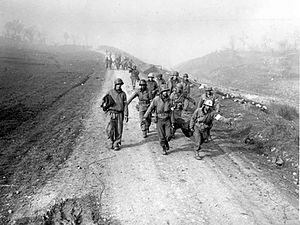Battle of Rapido River
| Battle of Rapido River | |||||||
|---|---|---|---|---|---|---|---|
| Part of the Battle of Monte Cassino, Italian Campaign | |||||||
 American soldiers bring back wounded during the attempt to span the Gari river near Cassino, Italy, January 1944. |
|||||||
|
|||||||
| Belligerents | |||||||
|
|
|
||||||
| Commanders and leaders | |||||||
|
|
|
||||||
| Strength | |||||||
| 2 regiments of the U.S. 36th Infantry Division | 1 regiment | ||||||
| Casualties and losses | |||||||
| 1,330 killed and wounded 770 captured |
64 killed 179 wounded |
||||||
The Battle of Rapido River was fought from 20 to 22 January 1944 in the course of the Battle of Monte Cassino, part of the Italian Campaign of World War II. Despite its name, the battle occurred on the Gari river.
Lieutenant General Mark Clark, Commanding General (CG) of the United States Fifth Army, in an attempt to break through the German defences of the Winter Line (also known as the Gustav Line), tried to cross the Gari river, south of Monte Cassino, with two regiments (the 141st and 143rd Infantry) of the U.S. 36th Infantry Division, commanded by Major General Fred Walker. After crossing the river in boats, the Americans were cut off from reinforcements and support and subjected to heavy fire and counterattacks from elements of the German 15th Panzergrenadier Division stationed on the west bank of the river. The Americans suffered very high losses and after two days of fighting the survivors retreated back across the river; two regiments were essentially wiped out in the failed attack.
Controversy followed the American defeat, with Clark criticizing Walker's execution of the battle plan and Walker responding that the entire battle had been foolhardy and unnecessary and that Clarks's plan, which he, Walker, had protested against, had all but guaranteed failure. The battle of the Rapido River was one of the largest defeats suffered by the U.S. Army during World War II and, after the war, was the subject of an investigation in 1946 by the Congress to establish responsibility for the disaster.
...
Wikipedia
